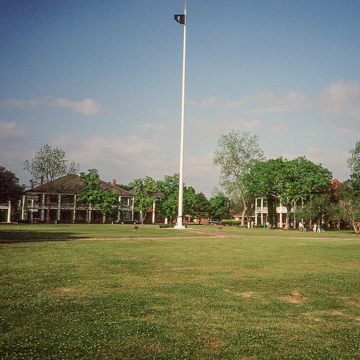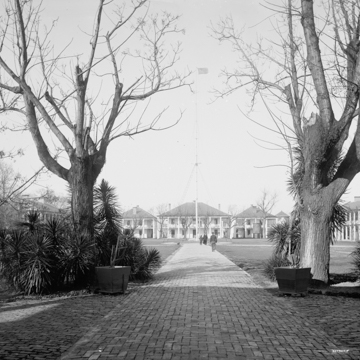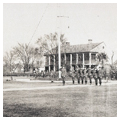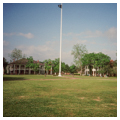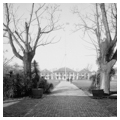Now the headquarters for Louisiana’s National Guard, Jackson Barracks was begun during Andrew Jackson’s presidency to house a federal garrison. Then known as the New Orleans Barracks, the complex was renamed in 1866 to honor the hero of the Battle of New Orleans. The barracks, which now extends one mile inland from its original site on the Mississippi River, includes more than sixty buildings, a museum, and several Air National Guard airplanes. Captain Frederick Wilkinson (1812–1841), then only twenty-one years old, designed the original scheme: a rectangular parade ground facing the river, measuring 300 × 900 feet, flanked on each of its long sides by three buildings and, at its head, by a group of four buildings arranged in a square formation. All of these red brick structures, designed to house the troops and officers, have two-story galleries with full-height white-painted Doric columns. A description of the barracks published in Architectural Art and Its Allies in November 1910 noted that the quarters for the enlisted men were “heated by open fireplaces, and lighted and ventilated by large windows,” but observed that during the long hot summers “the majority of the men sleep on the veranda.” The officers’ quarters were better equipped than those of the troops and included piped-in water.
The simplicity and proportions of these buildings, with their symmetrical layout and scale in relation to the parade ground (now a lawn), combine to form one of Louisiana’s most serene and magnificent spaces. Although many new buildings were added to the barracks in succeeding years, they were fortunately placed farther inland and did not disrupt Wilkinson’s scheme.
Shortly after completing the barracks, Wilkinson designed Cypress Grove Cemetery Gate and Lodge (OR197); he was later appointed deputy U.S. surveyor. The barracks have seen constant use as a debarkation point: for U.S. troops and Indians during the second Seminole War, for troops for the Mexican War, for Confederate and Union forces in the Civil War, and during World Wars I and II.
In 2005, Hurricane Katrina severely damaged the barracks, inundating the site with four feet of water at the river’s edge and around twenty feet at the St. Claude Avenue end. Many of the buildings have since been restored.
















